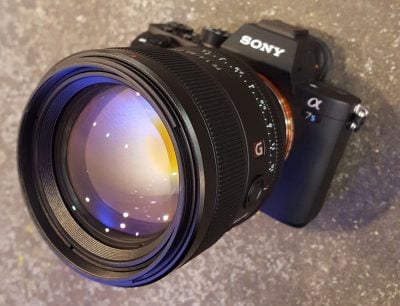Sony FE 85mm f1.4 GM review
-
-
Written by Thomas
Quality
Testing: Longitudinal Chromatic Aberration and focus shift
Lenses with focal ratios of f2.8 or larger are often prone to longitudinal color aberrations (loCA, a.k.a. “axial color” or “bokeh CA”). These show up as magenta coloration in the foreground and greenish hues in the background and are not easily corrected in post-processing. The Sony FE 85mm f1.4 GM is no exception: it shows quite strong loCA wide open but the effect is completely gone at f4.0. The following 100% crops show the foreground on the left and the background on the right with the first crop at 1.4, second at f2.0, third at f2.8:
Longitudinal Chromatic Aberration (loCA)
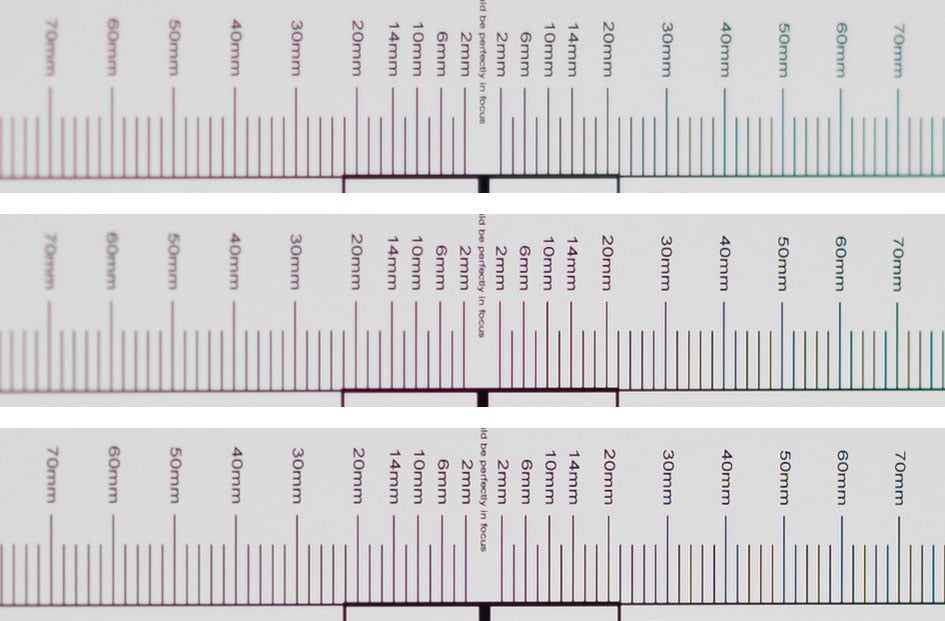
Above: Sony FE 85mm f1.4 GM at f1.4, f2.0, f2.8; 100% crops
The test also revealed that there is a very slight focus shift when stopping down from f1.4 to f2.0 but that should be taken care of by the autofocus using the actual aperture.
Both the Zeiss 85mm f1.4 Otus (see here) and the Sigma 85mm f1.4 Art (here) produce visibly less loCA wide open.
Sharpness and contrast
Let’s have a look at the theoretical performance of the Sony FE 85mm f1.4 GM first and compare it to the alternatives from Zeiss and Sigma:

Above from left to right: MTF Sony FE 85mm f1.4 GM, Zeiss 85mm f1.4 Otus, Sigma 85mm f1.4 Art
The MTF chart of the Zeiss Otus (middle) shows the measured contrast wide open at 10, 20 and 40 line-pairs per mm. This includes the influence of diffraction unlike the computed MTF charts from Sony (left) and Tamron (right) showing contrast at 10 lp/mm and 30 lp/mm. Higher values are better (more contrast) and the closer the line-pairs are together the less astigmatism (= resolution depends on the orientation of the test-pattern) the lens has. The x-axis displays the distance from the optical axis (=center of the sensor) in mm. I’ll show you the real-life performance at 4 mm (center), 13 mm (APS-C-corner), and 20 mm (FF-corner) on a 42MP Sony A7R II body.
From the charts the Sony FE 85mm f1.4 GM looks a bit softer than the Zeiss Otus or the Sigma Art. It should also show some strong astigmatism outside the APS-C image-circle where sagittal and meridional contrast show a huge gap. But let’s see how this theoretical performance of the Sony translates into real life results in the sharpness test based on Siemens-stars. Processing was done in Lightroom 8/CRAW 11 from RAW to Adobe Color profile with the built-in lens profile applied. Noise-reduction is set to 0, sharpening to 50/0.5/36/10, with no extra tone, color, or saturation adjustment. White-balance was adjusted to a neutral white and I did some exposure compensation to make the brightness of all crops match. So you will not see light fall-off in the corners. Removal of lateral color aberrations is ON, longitudinal CA are not corrected.
The following 100% crops show the Sony FE 85mm f1.4 GM from f1.8 down to f11 compared to the Zeiss 85mm f1.4 Otus and Sigma 85mm f1.4 Art at f1.4, plus I’ve added the Sony FE 85mm f1.8 at f1.8 for good measure. The Zeiss and the Sigma were shot on a 46MP Nikon D850 / 36MP D810 respectively with no lens profiles applied. The linear resolution of the D850 sensor is only 4% higher than from the Sony A7R II and of the D810 sensor 7% lower which should not make a visible difference in this comparison.
Sony FE 85mm f1.4 GM; 100% crop from center, APS-C/DX-corner, FF/FX-corner

Above: Sony FE 85mm f1.4 GM at f1.4

Above: Zeiss 85mm f1.4Otus on a 46MP Nikon D850 at f1.4; also available at f2.0, f2.8, f4.0, f5.6, f8.0, f11

Above: Sigma 85mm f1.4 Art on a 36MP Nikon D810 at f1.4; also available at f2.0, f2.8, f4.0, f5.6, f8.0, f11

Above: Sony FE 85mm f1.8 at f1.8; also available at f2.0, f2.8, f4.0, f5.6, f8.0, f11
In this comparison at f1.4 the Sony FE 85mm f1.4 GM shows very good performance in the APS-C image-circle only shortly behind the Zeiss Otus but a little bit better than the Sigma Art. But the Sony has strong coma/astigmatism in the FF-corner where it’s bested by the Otus and especially the Sigma Art which has extremely good FF-corners. A look at Sony’s smaller sibbling reveals that the FE 85mm f1.8 is the softest in this comparison although it profits from being shown at f1.8 here.
Now let’s see how the Sony FE 85mm f1.4 GM develops when stopped down:

Above: Sony FE 85mm f1.4 GM at f2.0

Above: Sony FE 85mm f1.4 GM at f2.8

Above: Sony FE 85mm f1.4 GM at f4.0

Above: Sony FE 85mm f1.4 GM at f5.6

Above: Sony FE 85mm f1.4 GM at f8.0

Above: Sony FE 85mm f1.4 GM at f11
Stopping Sony’s FE 85mm f1.4 GM down to f2.0 already helps the FF-corner sharpen up nicely – and even more so at f2.8. So if you need corner-to-corner sharpness from this lens you need not stop down too far.
Performance at long distances
The Siemens-star test-targets are shot at a distance of 45x focal length (i.e. at around 4m). But performance of lenses also depends on the shooting distance. Therefore I present another series of test-shots of a city around 1 km away. Processing was done in Lightroom 8/CRAW 11 from RAW to Adobe Color profile with the lens-profile for distortion and vignetting automatically applied. Noise-reduction is set to 0, sharpening to 50/0.5/36/10, with no extra tone, color, or saturation adjustment. I used autofocus at the largest aperture and did not change focus for other apertures. All shots were made at ISO 100 and image stabilization switched off.
The main image shows the complete scene wide open to give you an impression of the angle of view and to judge vignetting. You can access the respective shots up to f11 via the links beneath the main image. Following the main image are 100% crops from the Sony FE 85mm f1.4 GM down to f11 compared to the Zeiss 85mm f1.4 Otus at f1.4, and the Sony FE 85mm f1.8 at f1.8. All three lenses were shot on the same day only minutes apart with the Zeiss Otus being shot at ISO 64 on a 46MP Nikon Z7 which has a 4% higher linear resolution than the Sony A7R II but that should not make a visible difference.
You can click on each image to access the large original. Please respect our copyright and only use those images for personal use.
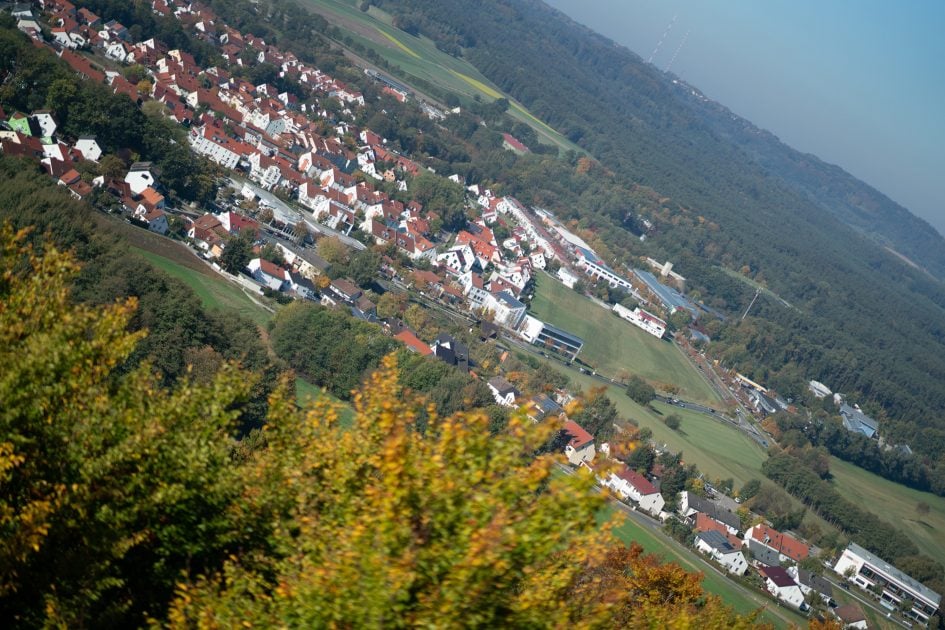
Above: Sony FE 85mm f1.4 GM at f1.4; click image to access original at Flickr; also available at f1.7, f2.0, f2.8, f4.0, f5.6, f8.0, f11

Above: Sony FE 85mm f1.4 GM at f1.4; 100% crop from center, APS-C-corner, FF-corner

Above: Zeiss 85mm f1.4 Otus on a 45MP Nikon Z7 at f1.4; 100% crop from center, APS-C-corner, FF-corner; also available at f1.8, f2.0, f2.8, f4.0, f5.6, f8.0, f11

Above: Sony FE 85mm f1.8 at f1.8; 100% crop from center, APS-C-corner, FF-corner; click image to access original at Flickr; also available at f2.0, f2.8, f4.0, f5.6, f8.0, f11
The Sony FE 85mm f1.4 GM is very sharp in the center but shows some green/cyan haloing around high-contrast edges which the Zeiss Otus lacks. The Sony FE 85mm f1.8 is a little softer in the center than the other two lenses. In the APS-C corner the Zeiss Otus delivers the sharpest result followed by the Sony GM and the Sony f1.8. In the FF-corner the Sony FE 85mm f1.4 GM is clearly the best followed by the FE 85mm f1.8 while the Zeiss Otus shows some strange “spiky” artifacts around the lettering in this shot that I have not seen before.
Let’s see how the Sony FE 85mm f1.4 GM develops when stopped down:

Above: Sony FE 85mm f1.4 GM at f2.0; 100% crop from center, APS-C-corner, FF-corner

Above: Sony FE 85mm f1.4 GM at f2.8; 100% crop from center, APS-C-corner, FF-corner

Above: Sony FE 85mm f1.4 GM at f4.0; 100% crop from center, APS-C-corner, FF-corner

Above: Sony FE 85mm f1.4 GM at f5.6; 100% crop from center, APS-C-corner, FF-corner

Above: Sony FE 85mm f1.4 GM at f8.0; 100% crop from center, APS-C-corner, FF-corner

Above: Sony FE 85mm f1.4 GM at f11; 100% crop from center, APS-C-corner, FF-corner
Stopping down to f2.0 reduces the haloing around high-contrast edges greatly and at f2.8 the effect is completely gone which lets the Sony FE 85mm f1.4 GM reproduce very finely details from corner to corner.
Vignetting
To make it easier to see light fall-off in the corners of a full-frame sensor I’ve arranged a series of shots with the Sony FE 85mm f1.4 GM, the Sigma 85mm f1.4 Art, and the Zeiss 85mm f1.4 Otus at different apertures. All images were developed to the same brightness in the center and the integrated lens profile applied to the Sony lens, Shading Compensation in camera was set to Auto. The Sigma and the Zeiss were shot on a Nikon D810 with no lens profiles applied in post-processing.
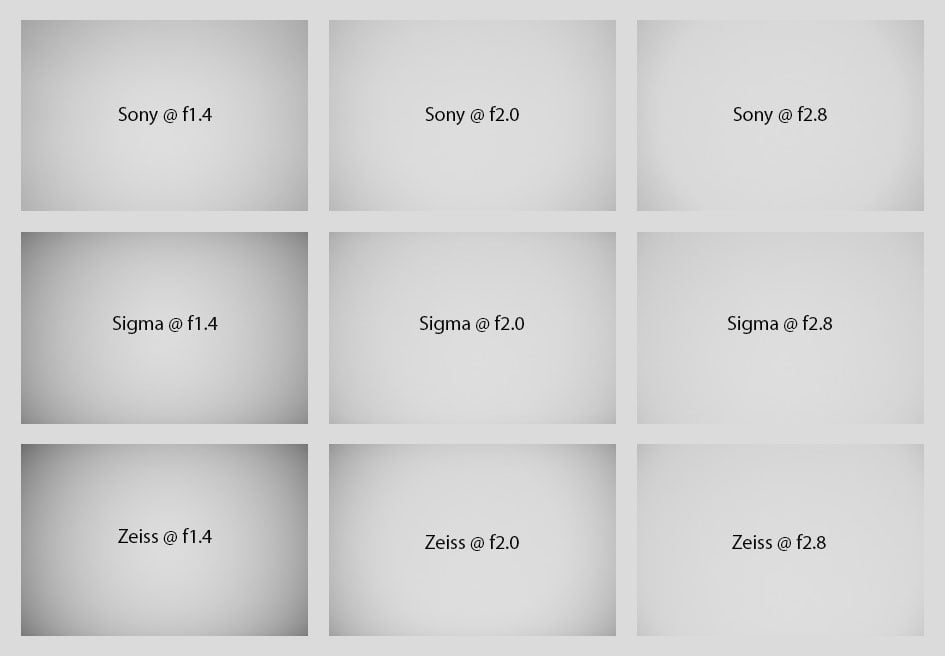
Above: Sony FE 85mm f1.4 GM vs. Sigma 85mm f1.4 Art vs. Zeiss 85mm f1.4 Otus at f1.4, f2.0, f2.8
The sample images above show that even with the lens profile applied vignetting of the Sony 85mm f1.4 GM still remains visible up to f2.8. With no lens profiles applied the Sigma Art and Zeiss Otus look much worse at f1.4 but very similar to the Sony GM at smaller apertures. If you apply the Adobe supplied lens profiles to them vignetting is almost completely eliminated, as you can see here. But then you can add some additional correction to the Sony GM too.
Rendering of point-light sources at night-shots
Night-shots pose a different challenge for lenses as the contrast is even higher than under bright sun and point-light sources can reveal some weaknesses such as coma, haloing and colour-aberrations that do not show up as prominently in other test-shots. The 100% crops below the main image show the effect of coma in the FF-corner of the Sony FE 85mm f1.4 GM, the Zeiss Otus, SIgma Art and Sony FE 85mm f1.8 at various apertures:
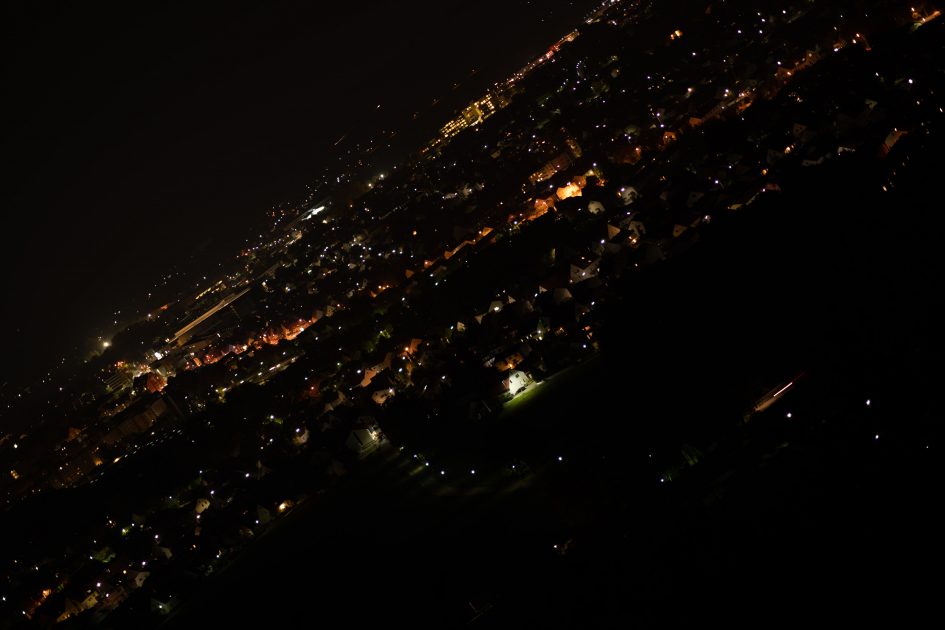
Above: Sony FE 85mm f1.4 GM at f1.4; click image to access original at Flickr; also available at f1.7, f2.0, f2.8, f4.0, f5.6, f8.0

Above: Sony FE 85mm f1.4 GM; 100% crops from the FF-corner at f1.4 (left), f2.0 (middle), f2.8 (right)

Above: Zeiss 85mm f1.4 Otus on a 36MP Nikon D810; 100% crops from the FF-corner at f1.4 (left), f2.0 (middle), f2.8 (right)

Above: Sigma 85mm f1.4 Art on a 36MP Nikon D810; 100% crops from the FF-corner at f1.4 (left), f2.0 (middle), f2.8 (right)

Above: Sony FE 85mm f1.8; 100% crops from the FF-corner at f1.8 (left), f2.8 (middle), f4.0 (right)
The Sony FE 85mm f1.4 GM produces quite some coma wide open. It is indeed the worst of the four lenses shown here – although the Sony FE 85mm f1.8 profits from being at f1.8 here. The best of the bunch is the Sigma Art. The Sony GM also shows some haloing around bright lights albeit not as strong as the FE 85mm f1.8 (shown here):

Above: Sony FE 85mm f1.4 GM at f1.4 (left) and f1.7 (right); 100% crop
The Sony FE 85mm f1.4 GM needs to be stopped down to f2.8 to avoid this effect.
Rendering of out-of-focus point-light sources
This test is for the rendering of point-light sources in an out-of-focus background. The circle of confusion that is produced by this test is pretty indicative of Bokeh performance (in the background) and light fall-off. Ideally the out-of-focus image of the point-light is evenly lit and perfectly circular, with no “onion-rings”, and without coloration. Large aperture lenses normally produce an effect known as “cat’s eye” the further away from the optical axis the point-light is projected. This is due to optical vignetting in the lens barrel when light enters the lens from an angle.
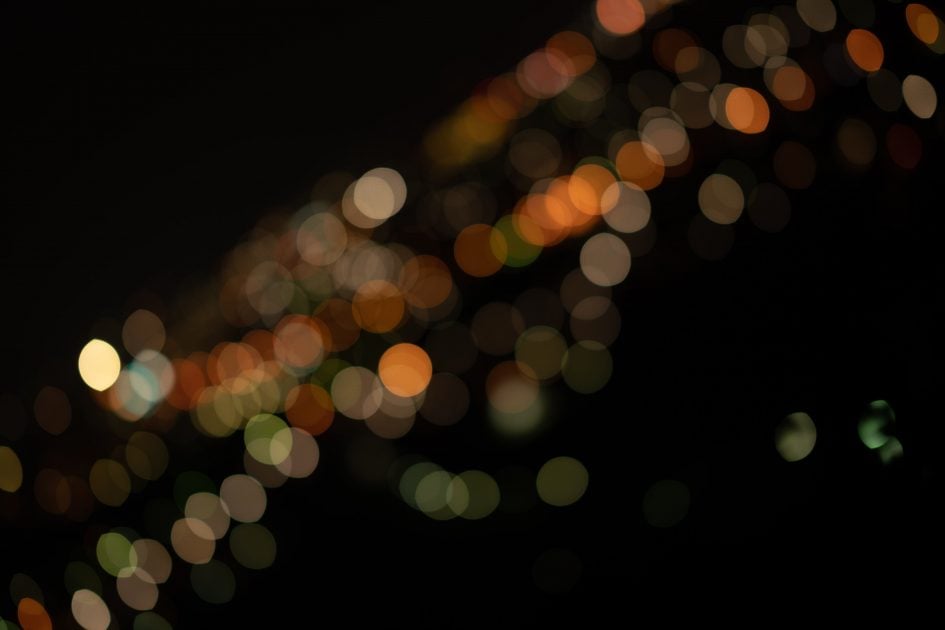
Above: Sony FE 85mm f1.4 GM at f1.4; click image to access original at Flickr; also available at f1.7, f2.0, f2.8, f4.0, f5.6, f8.0

Above: Sony FE 85mm f1.4 GM at f1.4; 46% crops from center, APS-C-corner, FF-corner

Above: Zeiss 85mm f1.4 Otus on a 36MP Nikon D810 at f1.4; 50% crops from center, APS-C-corner, FF-corner; also available at f1.8, f2.0, f2.8, f4.0, f5.6, f8.0

Above: Sigma 85mm f1.4 Art on a 36MP Nikon D810 at f1.4; 50% crops from center, APS-C-corner, FF-corner; also available at f1.8, f2.0, f2.8, f4.0, f5.6, f8.0

Above: Sony FE 85mm f1.8 at f1.8; 46% crops from center, APS-C-corner, FF-corner; also available at f2.0, f2.8, f4.0, f5.6, f8.0
A few things are of note here:
- The Bokeh balls of the Sony GM are very smooth inside with no onion rings – although the lens has an aspherical element. In fact it is almost as smooth as the Sony f1.8 which does not employ an asperical lens element.
- Outlining is very moderate with the Sony GM lens but you can see some green coloration from longitudinal CA which the Zeiss Otus lacks.
- Compression of the Bokeh balls is relatively low at the APS-C-corner for the Sony GM and the Sigma Art with the Zeiss Otus und the Sony f1.8 trailing behind.
- In the far FF-corner you can see the clipping from the mirrorbox of the Nikon D810 in the shots with the Zeiss Otus and the Sigma Art. That would not happen on a mirrorless body.
- The size of the Bokeh balls in the center crop of the Sony FE 85mm f1.8 is not directly comparable to the f1.4 lenses as the magnification of this lens was accidentally set a bit higher than usual. The diameter should be proportional to the entrance pupil of a lens which is this case is 47mm for the f1.8 lens and 61mm for the f1.4 lenses.
Let’s see how this analysis of out-of-focus point-light sources translates into Bokeh-performance shooting a book-shelf.
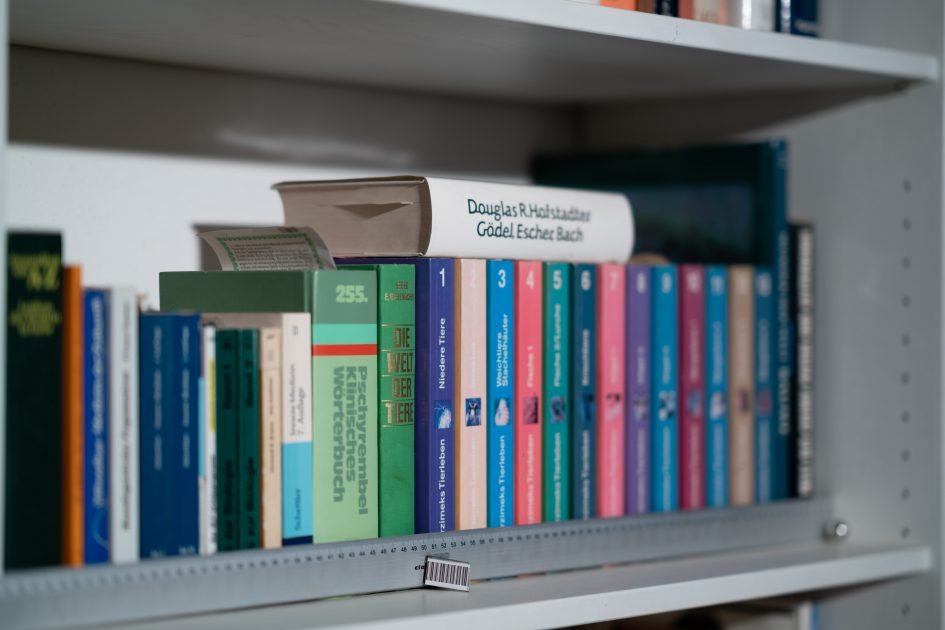
Above: Sony FE 85mm f1.4 GM at f1.4; click image to access original at Flickr; also available at f1.7, f2.0, f2.8, f4.0, f5.6, f8.0

Above: Sony FE 85mm f1.4 GM at f1.4; 46% crops from foreground, middle-ground, background

Above: Zeiss 85mm f1.4 Otus on a 36MP Nikon D810 at f1.4; 50% crops from foreground, middle-ground, background; also available at f1.8, f2.0, f2.8, f4.0, f5.6

Above: Sigma 85mm f1.4 Art on a 36MP Nikon D810 at f1.4; 50% crops from foreground, middle-ground, background; also available at f1.8, f2.0, f2.8, f4.0, f5.6, f8.0

Above: Sony FE 85mm f1.8 at f1.8; 46% crops from foreground, middle-ground, background; also available at f2.0, f2.8, f4.0, f5.6, f8.0
The Sony FE 85mm f1.4 GM has a very creamy Bokeh in the background and produces a soft albeit “colorful” transition in the middle-ground. The less important forground is not the forte of this lens. The Sigma 85mm f1.4 Art overall produces the best Bokeh with the Zeiss Otus showing the least color aberrations but suffers a bit from a nervous rendering. But all three f1.4 lenses easily beat the only f1.8 contender in this comparison which shows again why f1.4 lenses are sought after for producing the softest Bokeh.
Here’s how it looks in a portrait shot:

Above: Sony FE 85mm f1.4 GM; click image to access 4k version

Above: Sony FE 85mm f1.4 GM at f1.8, 50% crop; for 100% crop click at f1.4, f1.7, f2.0, f2.8, f4.0, f5.6
The same shots were done within minutes with the Sony FE 85mm f1.8:

Above: Sony FE 85mm f1.8 at f1.8, 50% crop; for 100% crop click at f1.8, f2.8, f4.0, f5.6
Again the f1.4 lens blurs the background stronger than the f1.8 lens.
Flare, ghosting, and sun-stars
Catching a strong light-source shining directly into the lens is always a risky business: it could produce strange colourful ghost-images or reduce contrast considerably through flare and glare. The appearance of flare and ghosting depends on factors like the aperture and the angle of the light hitting the lens. So to judge the proclivity of the Sony FE 85mm f1.4 GM for these artefacts I went through a series of well calculated shots against a strong light source to provoke glare and ghosting.
The Sony FE 85mm f1.4 GM is quite prone to flare and ghosting artefacts. The following image at f11 is one of the most obvious examples:
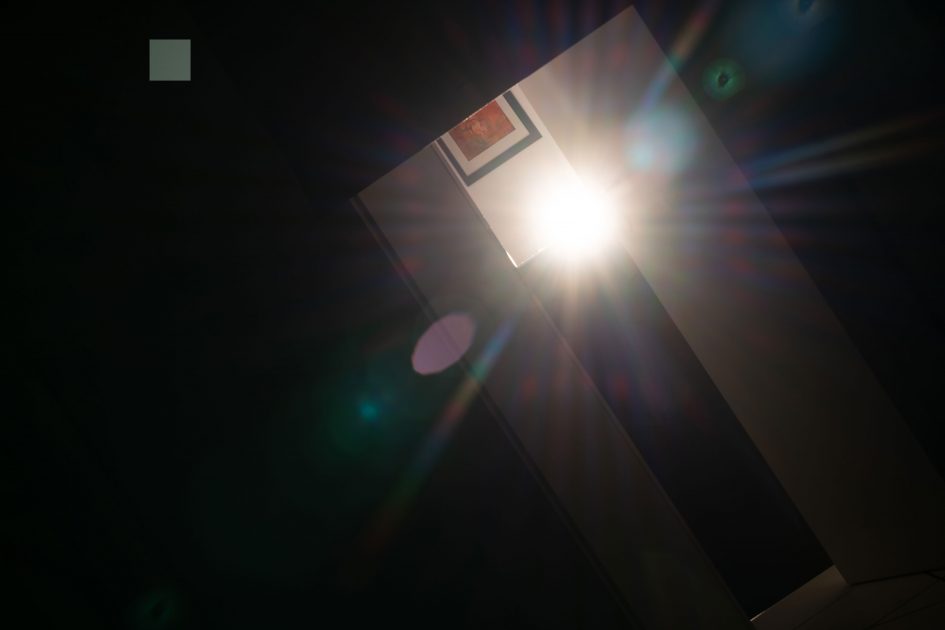
Above: Flare and ghosting. Strong light hitting the Sony FE 85mm f1.4 GM at f11
The little square inset in the upper left of the image shows the respective area with an exposure compensation of +3 EV to make it easier to see which levels of black the lens renders at that point. It clearly shows that the Sony FE 85mm f1.4 GM also suffers from quite some veiling glare. And you better watch out, when the light-source is just outside the corner as it can produce some nasty streaks across the image:
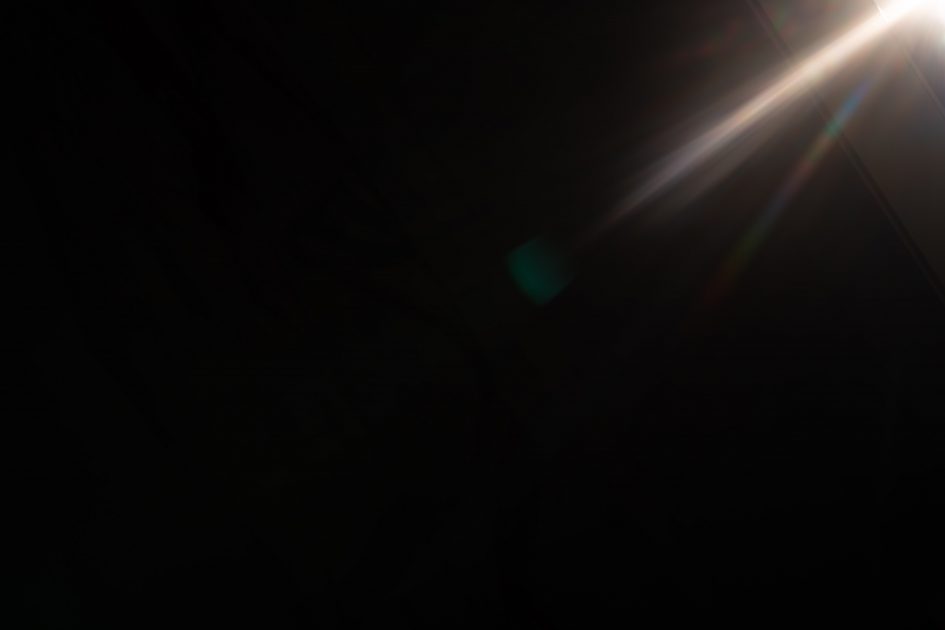
Above: Flare and ghosting. Strong light hitting the Sony FE 85mm f1.4 GM at f11
The lens produces nice sunstars even at f5.6 and more so when you stop down further:

Above: Sunstars of Sony FE 85mm f1.4 GM at f5.6, 100% crop
Next check out my sample images!
Check prices on the Sony FE 85mm f1.4 GM at Amazon, B&H, Adorama, or Wex. Alternatively get yourself a copy of my In Camera book or treat me to a coffee! Thanks!




